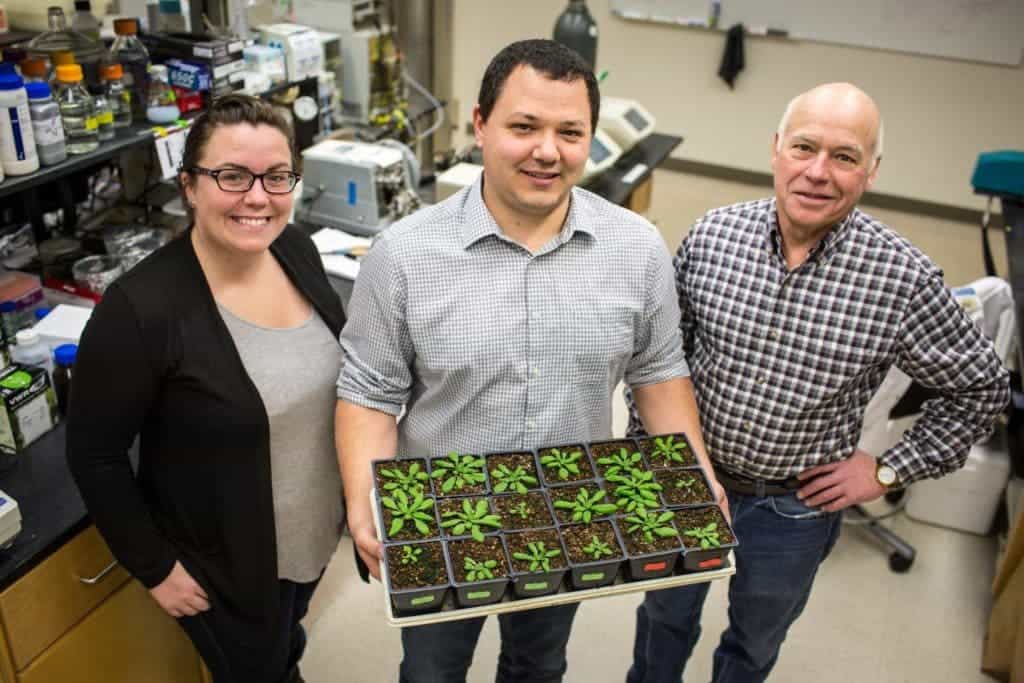Every single day, plants transform carbon into food — but sometimes, some plants transform carbon into a plant-toxic compound, drastically reducing yields. The newly identified protein transports the toxic product, called glycolate, ensuring that it can be recycled into a useful sugar molecule.

During photosynthesis in C3 crops, such as wheat and rice, the enzyme Rubisco will react with oxygen (instead of carbon dioxide) creating a plant-toxic compound that must be recycled, wasting energy. University of Illinois researchers — including USDA/ARS scientist Paul South (center), USDA/ARS scientist Don Ort (right), and Amanda Cavanagh (left) — report in Plant Cell the discovery of a key protein in this process, which they hope to manipulate to increase plant productivity.
“Photorespiration is essential for C3 plants, such as rice and soybeans, but operates at the massive expense of fixed carbon and energy,” said project lead Don Ort, USDA/ARS scientist and the Robert Emerson Professor of Plant Biology at Illinois. “We have identified photorespiration as a primary target to improve photosynthetic efficiency as a strategy to improve crop yield. Successfully re-engineering photorespiration requires deep knowledge of the process, for which understanding of transport steps is most lacking.”
Photosynthesis is the process through which plants (and other organisms such as algae) convert light energy into chemical energy for later release. There are several ways through which carbon dioxide is absorbed in the process. C3 carbon fixation is one of three metabolic pathways for carbon fixation in photosynthesis, converting carbon into an organic substance called ribulose bisphosphate.

Many plants accidentally make a plant-toxic compound during photosynthesis that is recycled through this process, called photorespiration. Image credits: Many plants accidentally make a plant-toxic compound during photosynthesis that is recycled through this process, called photorespiration. Image credits: Realizing Increased Photosynthetic Efficiency.
Basically, researchers want to bypass the plant’s regular way of dealing with glycolate and in the process, save the plants a lot of energy and prevent them from releasing ammonia, which is harmful to them.
“Now we’re going to try to make a shortcut to avoid all the wasteful steps in photorespiration,” said Paul South, a USDA/ARS postdoctoral researcher who led this work at the Carl R. Woese Institute for Genomic Biology at Illinois. “We’re building a shortcut to quickly process glycolate into glycerate instead of letting BASS6 and PLGG1 take the country roads. One of the benefits of the shortcut is that the plants don’t produce ammonia, so they don’t have to spend a lot of energy re-fixing the ammonia.”
It might not seem like much, but photorespiration is a massive problem in farming, as researchers themselves explain:
“We could feed around 200 million people with the calories lost to photorespiration each year just in the Midwestern United States,” said co-author author Berkley Walker, an Alexander von Humboldt Postdoctoral Fellow at the University of Düsseldorf, citing his recently published simulations. “While we can’t get all that yield back, even saving 5% of the energy in lost in photorespiration would be worth millions of dollars annually.”
Journal Reference: Paul F South, Berkley J Walker, Amanda P Cavanagh, Vivien Rolland, Murray Badger and Donald R. Ort — Bile Acid Sodium Symporter BASS6 Can Transport Glycolate and Is Involved in Photorespiratory Metabolism in Arabidopsis thaliana. doi: http:/ / dx. doi. org/ 10. 1105/ tpc. 16. 00775









